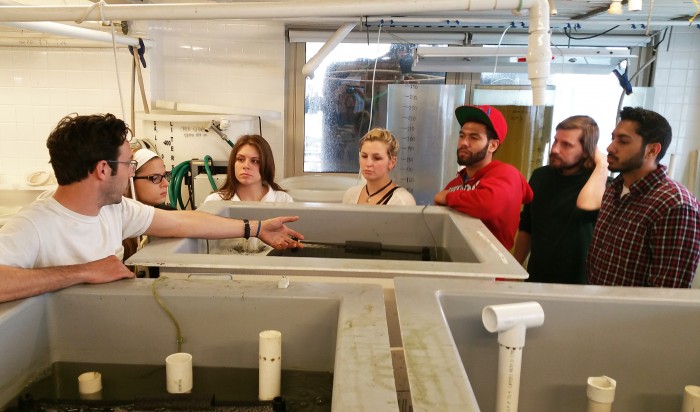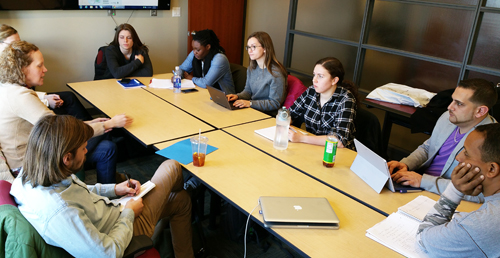![By Balajijagadesh (Own work) [CC0], via Wikimedia Commons](https://earthdesk.blogs.pace.edu/files/2015/07/Constitution_of_india.jpg)
By Balajijagadesh (Own work) [CC0], via Wikimedia Commons
Ed. Note: Kiefer Kofman, Pace ’16, is a political science major and the former head of the Community Energy Team at the Pace Environmental Policy Clinic. He is studying in India under a Benjamin A. Gilman International Scholarship. His first post, Into the World of India, appeared on June 23.
«« »»
THE INDIAN CONSTITUTION is the longest in the world, and one of the most ambitious. To read it, one would believe the social, economic, and human rights codified in 1949 describe a nation far more advanced than many western nations.

Kiefer and friends.
The Indian Constitution is near superfluous, however. By and large, Indian culture has clung to an antiquated caste system that has had systemic impacts not because the Indian population has widely bought into it, but because it benefits a small elite, many of whom are charged with outlawing just such a system.
Coming to India, I wanted to understand the core, institutional issues that allowed it to economically grow while human development continued to lag. Unlike economic inequality in the United States where disparity can be obfuscated, economic inequality in India is blunt and omnipresent. On one side of the street may be a five star hotel, and on the other a slum. For this to persist, I began to think, there had to be a certain degree of acceptance by those in the upper and middle classes, that Indian society naturally allows for winners and losers.
In fact, it is much worse. India’s cultural tradition of the caste system has been a primary cause not simply for economic inequality. It has sanctioned poverty by castigating the poor as deserving of their place. Though the caste system has become more politically incorrect in India over the years and the practice is also outlawed by the Indian constitution, it remains in a deeply cultural form.
Environmental reform in India will not come unless a cultural acceptance of economic equality takes hold first.
Although its origin is disputed, the caste system’s beginnings lies in the Rigveda, one of four Hindu scriptures. There are four main castes: 1) Brahmin- priests, teachers; 2) Kshatriyas- rulers, warriors; 3) Vaisyas- skilled traders, merchants, and land cultivators; and 4) Shudras/Untouchables- unskilled workers, outcastes. The higher castes believed that untouchables deserve their untouchability because of what they must have done in previous lives. This means that the higher castes will not acknowledge, touch, or come anywhere near untouchables. There is no choice, no decision, and nearly no ability to move out of one’s caste. One is born into it and remains in it for life – even if one is able to move up economically.
For years the caste system allowed the British to accentuate their control over the Indian colony. Even after India gained independence and its constitution outlawed the practice, the caste system was so much a part of Indian culture untouchables remained the victims of crime, rape, subjugation, and brutal oppression. In recent years, however, the caste system has grown taboo among the educated in India, and more lower castes have been able to move themselves up economically despite insurmountable odds.
Despite the advancements, however, the caste system remains engrained in Indian society. Indians can sniff out one’s caste; thus, leading to myriad cases of discrimination and crime. For example, an extensive study done by Ahmedabad based NGO ‘Navsarjan Trust’ with the help of the Robert F. Kennedy Center for Justice and Human Rights, studied over 1,600 villages in the northeastern Indian state of Gujarat. The report found more than 98% of the villages continued to practice untouchability.
More daunting, however, is the higher caste’s immunity in India. Gujarat, under now Prime Minister Modi, former Chief Minister of Gujarat, rather than cracking down on untouchability, created a committee under the minister of social justice to refute the findings of the report. This class slavery continues onward, both subtly and blatantly, because the influential higher caste of society rarely punish those in their own caste.
A variety of factors allow India to remain grossly unequal. The caste system is a salient cultural reason as to why inequality is so difficult to reform in India, as opposed to other large economies. If India seeks to create a more inclusive economy, the caste system must continue to wither away. Moreover, there is a direct connection to the environment here; especially due to India’s critical role in assuaging climate change.
Many upper caste individuals and elites of Indian society feel exempt from legal and economic reform. They hold great sway over industry-friendly and labor policies, allowing them to continue to benefit from a system that shuts out those in the middle and lower class and castes.
Environmental reform in India will not come unless a cultural acceptance of economic equality takes hold first. The complexity of its social and economic landscape transcends any one issue, whether income inequality, pollution, crime, or corruption. India’s attachment to antiquated and unjust traditions and beliefs must evaporate if it is to evolve into a truly advanced, democratic and sustainable nation.









